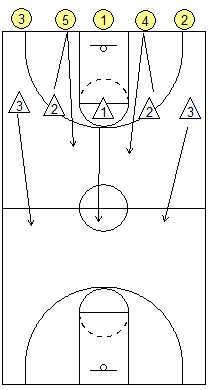Basketball Drill - 5-on-3 Transition Defense Drill
By Dr. James Gels, From the Coach’s Clipboard Basketball Playbook"Helping coaches coach better..."
Disclosure: This page contains affiliate links, which means that Coach's Clipboard receives a small commission (at no cost to you) if you make a purchase using these links.
This drill comes from Creighton University Head Coach Greg McDermott and focuses on defensive transition, sprinting back when at a disadvantage, and communication between the defenders.

Coach Greg McDermott
Running the Drill
See the diagram below. Five defenders line up across the free-throw line extended, facing the baseline. Five offensive players are on the end line. The defenders are numbered 1, 2's and 3's. The coach stands next to X1 and starts the action by throwing the ball to one of the offensive players, and yelling out one of the three numbers ("2" in the diagram below). The offense immediately gets the ball up the court as quickly as possible, looking to score in transition. They are only allowed 12 seconds to score.
The two defenders whose number was called (here "2") must first sprint and touch the baseline before sprinting back on defense. The other three defenders sprint back and try to delay or stop the 5-on-3 attack waiting for their two teammates to sprint back into the defense.
If coach calls either number "2" or "3", you will have 5-on-3. If he calls "1", it will be a 5-on-4 situation.
A strategy that Coach McDermott uses is for the first three defenders to try to force the ball to one side of the court (diagram 2), where they can get one of the three defenders in a helpside position. Then as the trailing defenders come in late, they should fill the weakside.

Another rule for the first three defenders is to not allow a dribble to baseline as usually there will be no helpside in transition. The trailing defenders will be sprinting toward the middle or weakside and it's best to force the dribble into the middle where the help will be coming.
If the offense scores, or the defense rebounds or gets a steal, they move quickly up the floor 5-on-5 and try to score.